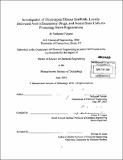Investigation of electrospun fibrous scaffolds, locally delivered anti-inflammatory drugs, and neural stem cells for promoting nerve regeneration
Author(s)
Vacanti, Nathaniel (Nathaniel Martin)
DownloadFull printable version (10.42Mb)
Other Contributors
Massachusetts Institute of Technology. Dept. of Chemical Engineering.
Advisor
Robert S. Langer.
Terms of use
Metadata
Show full item recordAbstract
The organization and intricacy of the central and peripheral nervous systems pose special criteria for the selection of a suitable scaffold to aid in regeneration. The scaffold must have sufficient mechanical strength while providing an intricate network of passageways for axons, Schwann cells, oligodendrocytes, and other neuroglia to populate. If neural regeneration is to occur, these intricate passageways must not be impeded by macrophages, neutrophils, or other inflammatory cells. Therefore it is imperative that the scaffold does not illicit a severe immune response. Biodegradable electrospun fibers are an appealing material for tissue engineering scaffolds, as they strongly resemble the morphology of extracellular matrix. In this study, electrospun fibers composed of poly(L-lactic acid) (PLLA) and polycaprolactone (PCL) were prepared with and without the steroid anti-inflammatory drug, dexamethasone, encapsulated. Histological analysis of harvested subcutaneous implants demonstrated the PLLA fibers encapsulating dexamethasone (PLLA/dex fibers) evoked a much less severe immune response than any other fiber. These findings were supported by in vitro drug release data showing a controlled release of dexamethasone from the PLLA/dex fibers and a burst release from the PCL/dex fibers. The ability of the PLLA/dex fibers to evade an immune response provides a very powerful tool for fabricating tissue engineering scaffolds, especially when the stringent demands of a neural tissue engineering scaffold are considered. Structural support and contact guidance are crucial for promoting peripheral nerve regeneration. A method to fabricate peripheral nerve guide conduits with luminal, axially aligned, electrospun fibers is described and implemented in this study. The method includes the functionalization of the fibers with the axonal outgrowth promoting protein, laminin, to further enhance regeneration. The implantation of stem cells at the. site of a spinal cord or peripheral nerve lesion has been shown to promote nerve regeneration. Preliminary work to isolate and culture pluripotent, adult neural stem cells for seeding on the above mentioned scaffold is also described here.
Description
Thesis (S.M.)--Massachusetts Institute of Technology, Dept. of Chemical Engineering, 2010. Cataloged from PDF version of thesis. Includes bibliographical references (p. 79-82).
Date issued
2010Department
Massachusetts Institute of Technology. Department of Chemical EngineeringPublisher
Massachusetts Institute of Technology
Keywords
Chemical Engineering.